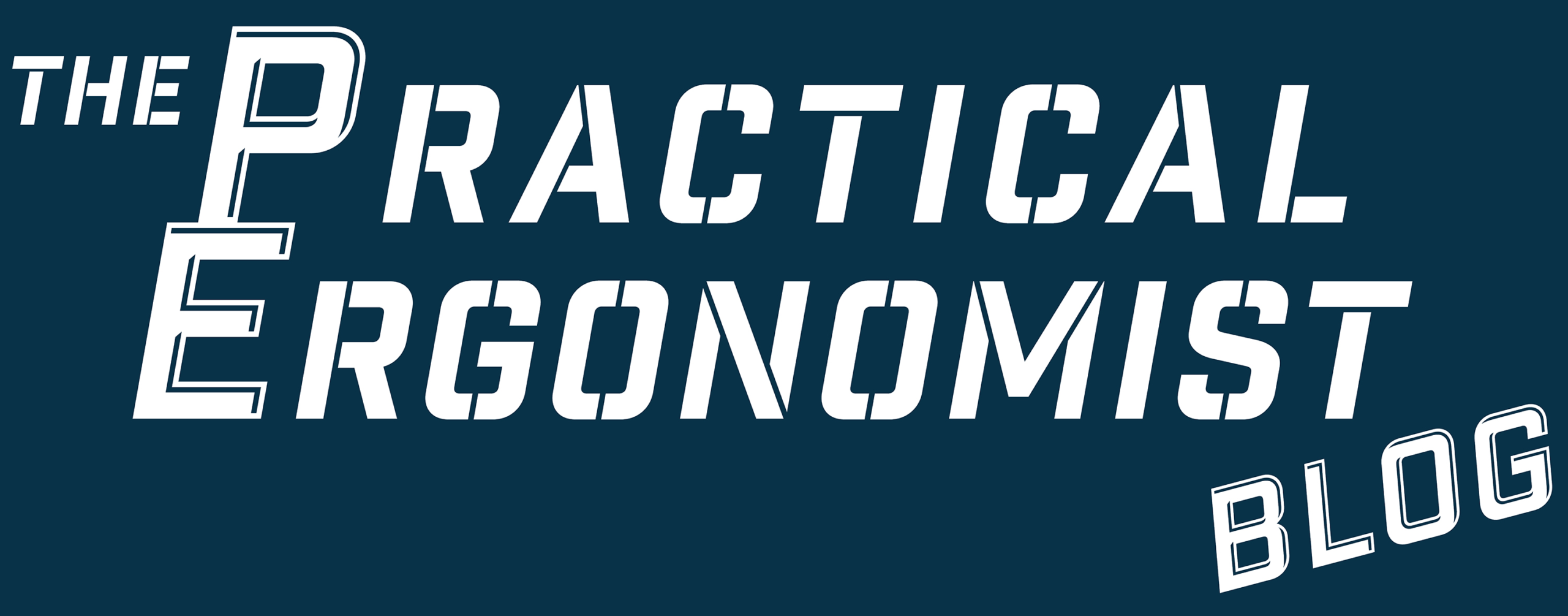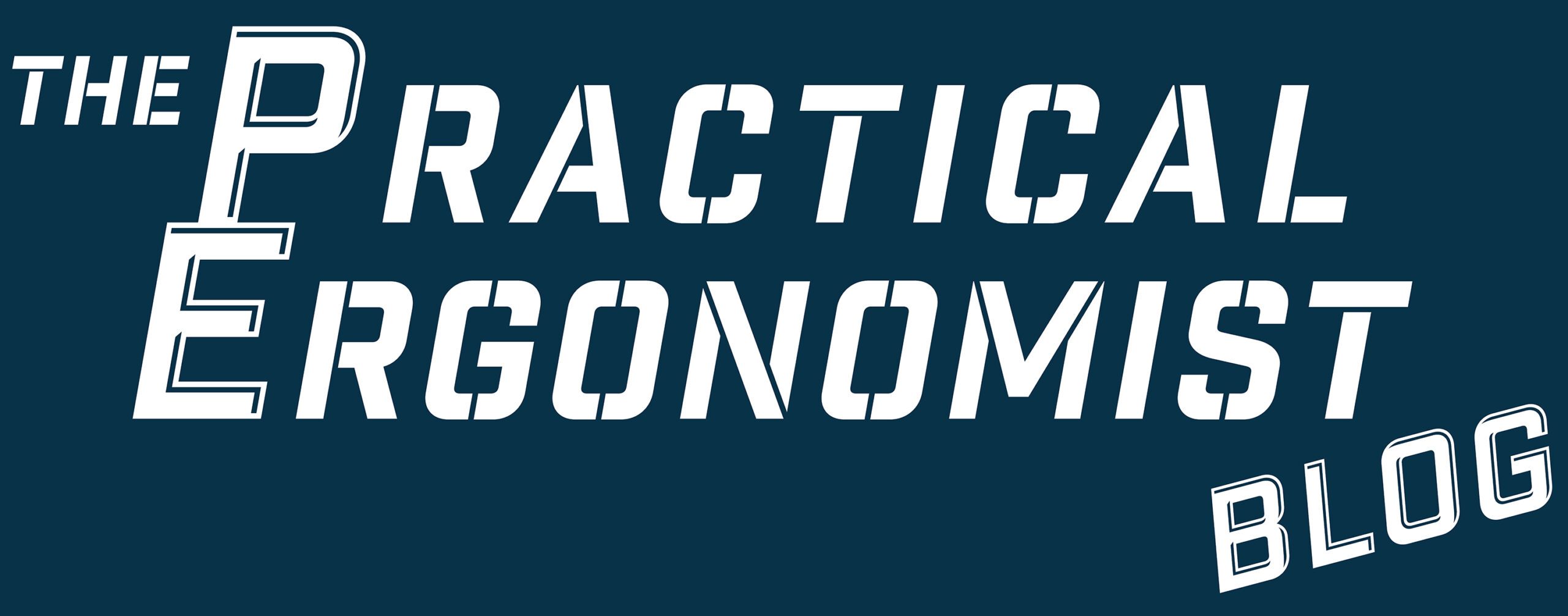The term ergonomics gets used all the time. It sounds smart and sells products, but what does it really mean? I will break down what the term ergonomics means and why ergonomics is literally all around you.
What is Ergonomics?
[This most common slide title in every ergonomics training slide deck.]
According to Merriam-Webster Dictionary, ergonomics is “an applied science concerned with designing and arranging things people use so that the people and things interact most efficiently and safely.” Other terms used to describe ergonomics are human factors and user experience.
I have found that each use of the term has a specific niche but are all related to system and human interaction. User experience tends to be focused on how the user interacts with technology. Human factors leans towards the physical design of controls, tools, and equipment we use. Ergonomics is generally associated with safety in an occupational world.
The International Ergonomics Association places Human Factors and Ergonomics into three buckets: cognitive, organizational, and physical. Cognitive deals with how we as humans interact with computers. Organizational revolves social systems and the environments that we work in. And lastly, physical pertains to human anatomy, anthropometrics, and biomechanics.
I am personally a physical ergonomist and have been practicing in industry for over 15 years. Yes, I care about the cognitive side and the organizational side too, but the physical and occupational sides are my personal specialty.
The impact of physical ergonomics and how we interact with everyday items is profound.
I’ll give you my personal definition of ergonomics as I have practiced and taught it over the years. No one likes long, complex, hard to comprehend definitions. When I teach the average workers what ergonomics is, I define it in three simple words:
- Safety
- Quality
- Efficiency
Safety
Injury prevention is the pinnacle goal of occupational safety. Ensuring that tasks and processes are free from as much risk as possible is the end goal. Risk in the world of ergonomics revolves around what we call “ergonomic risk factors”. These risk factors are categorically:
- Posture
- Force
- Repetitive Motion
- Contact Stress
- Static Loading
- Vibration
- Speed
- Sound
- Light
- Temperature
Ergonomic risk as it relates to these risk factors is cumulative.
Individual categorical risk of each factor added together gives you the total risk of a tool or task. To reduce the risk for injury, you reduce the risk of one or more risk factors. It’s a pretty simple concept.
What type of injury are mainly trying to prevent in ergonomics?
Sprains, strains, and other soft tissue injuries – also known as musculoskeletal injuries. These types of injuries are a pretty big deal to companies. They are silently affecting organizations across the United States costing a good chunk of change. Per the National Safety Council, musculoskeletal injuries have a median of 14 days away from work. Think about the impact of losing one of your employees for nearly 3 weeks…
How do you fill in that void in your business as you continue to pay worker’s compensation, medical bills, and you’re likely losing some level of productivity?
I cannot say it enough that prevention is key. In my professional opinion, we have a tremendous opportunity in front of us. We can spend thousands of dollars on the best tools and processes, yet the risk remains, particularly in the physical trades. It is difficult and frankly cost prohibitive to create engineering controls for every situation. Ask yourself this – much have we spent on coaching sound ergonomic principles and techniques?
Quality (or predictability)
All businesses are on a continual conquest to achieve the highest quality product or service. As a customer, this is what I expect and pay for with a product. While this is important, I will frame quality in the perspective of someone performing work differently. In the safety and ergonomics world, quality is about expectations and outcomes. This is where standards can come into place. OSHA sets expectations in 29 CFR part 1910 and provides criteria for employers to follow to ensure the health and safety of their employees.
Ergonomics Standards
There is currently no regulated ergonomics standard. Various forms of ergonomics standard practices and guidelines can be found through ISO, ANSI, United States Military , NASA, the FAA and so forth where they set parameters and expectations for design of tools, equipment, and processes. They are great places to find detailed information. Standards are based on populations size (or anthropometrics), strength, and capabilities of a population.
It is important to understand your population. I highly encourage you to have a standard or set of guidelines that you use for your organization or business. Engineers, designers, and facilities services teams like to know what their boundaries are during the design processes. Having set metrics will help you defend ergonomics, but will also play a pivotal role in your strategy to prevent through design.
Predictability
We as employees and consumers have an expectation of ergonomics in the design of tasks, tools, and equipment we use. I tell people in manufacturing that by following ergonomics guidelines around pushing and pulling forces, there comes a level of predictability that inherent to the comfort, satisfaction, and safety to that job. Imagine picking up a wrench knowing how hard one is required to push or pull on it versus a wrench that requires an unknown level of force. Which circumstance do you think is more safe? … The one with more knowns.
Think about it. For example, if we know something weighs a lot, we are going to mentally and physically prepare ourselves differently. From how we position our feet, to how we bend out knees, to where we place our hands and so on. This is learned through personal experiences. Personal experience could also be the result of injury too. So let’s get ahead of it now.
Efficiency
While speed and productivity are important, efficiency in terms of ergonomics revolves around energy expenditure. There is a saying, “work smarter, not harder.” I can literally mean this when I talk about efficiency and ergonomics.
As metrics and data drives business, it should drive ergonomics too. Energy efficiency and ergonomics can be measured by energy output. It is difficult to objectively measure energy output unless you have a fancy university laboratory to use. If we did though, it can be measured through caloric output or through respiration or other metabolic output measurements. Since most do not have access to this type of equipment, we are forced to go more on the subjective side of measurement.
A Likert scale (or numerical rating) can be used. I have used a 1-10 scale that I call the “Level of Exertion” scale. This works for observing perceived force and for energy output. Simply put, it’s a self-assessment or observable rating of how hard someone is working.
The harder someone works, the more prone to fatigue that will become. Fatigue can lead to dissatisfaction, human error, decreased productivity, or even injury.
So is ‘ergonomics’ a buzzword?
In short, I believe so. Many have heard the word, but cannot state what it is. I have seen this in nearly every single coaching session that I have given. The concept is all around us though. It is measurable and definable.
Everything we do has something to do with ergonomics.
It’s not just how to properly lift. It’s not just how a computer mouse fits the hand. From how posture when we lay in bed, to how we cut vegetables in the kitchen, to how we interact with digital technology, to how we lift a box . . . ergonomics is everywhere.
Ergonomics has come a long way. Some physical jobs have gotten easier and more safe. But we aren’t done yet. Product design hasn’t fixed it all yet, which is why everyone should get some level of ergonomics coaching because let’s face it – doesn’t matter if we are at work or at home – we need to get the job done. Our postures, the pushing, pulling, or lifting forces that we exert, the contact stress, repetitive motion, static postures, vibration, and others are all affecting not just what we are doing, but how we are doing it.
Start to deepen your understanding of ergonomics
I recommend basic ergonomic coaching for all. Where to start? Chances are you use a phone, tablet, laptop, or personal computer a fair chunk of time per day. This means that a great place to start is taking “Beyond the Office: Digital Ergonomics for the Every Day Person”. Ask your employer to pay for it if you are desk jockey – it only takes an hour or two and you will be blown away with information that I bet you didn’t even realize.




Leave a Reply